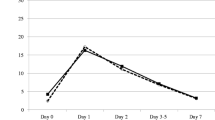Abstract
Two NSAIDs—nepafenac 0.1% and ketorolac tromethamine 0.4%—were compared in terms of their effects on corneal reepithelialization and pain after photorefractive keratectomy (PRK) in a randomized, double-masked, contralateral eye, multicenter study. A total of 40 healthy adult patients who were undergoing sequential bilateral PRK received nepafenac 0.1% and ketorolac 0.4% in contralateral eyes, 1 drop 3 times daily for 3 d after bandage contact lens insertion. Patients were assessed on postoperative days 1, 3, 4, 5, and 7. At each visit, patients provided a general rating of pain. Each patient also assessed the sensation of each eyedrop following instillation (after-drop pain, irritation, burning/stinging, and overall comfort). Starting on day 3, epithelial defect size was assessed. Mean epithelial defect size was similar between treatments at each postoperative visit (P > .05). The average time-to-healing was 4.18 d for nepafenac 0.1 % and 4.00 d for ketorolac 0.4% (P=.3134). No statistical difference was observed between nepafenac 0.1% and ketorolac 0.4% in mean postoperative pain scores (P > .05). On day 3, the nepafenac 0.1% group had significantly lower mean sensation scores than did the ketorolac 0.4% group for after-drop pain (P=.0090), irritation (P=.0007), and burning/ stinging (P=.0003). Mean overall comfort score was also significantly better for nepafenac 0.1% on day 3 (7.43 vs 6.41; P < .0001). Nepafenac 0.1% and ketorolac 0.4% provide postoperative pain relief after PRK surgery without associated adverse effects on corneal epithelial healing. Nepafenac 0.1 % treatment may offer greater comfort upon instillation in patients who have undergone PRK.
Similar content being viewed by others
References
Ambrosio R Jr, Wilson S. LASIK vs LASEK vs PRK: advantages and indications.Semin Ophthalmol. 2003;18:2–10.
Steinert RF, Bafna S. Surgical correction of moderate myopia: which method should you choose? II. PRK and LASIK are the treatments of choice.Surv Ophthalmol. 1998;43:157–179.
Assouline M, Renard G, Arne JL, et al. A prospective randomized trial of topical soluble 0.1% indomethacin versus 0.1% diclofenac versus placebo for the control of pain following excimer laser photorefractive keratectomy.Ophthalmic Surg Lasers. 1998;29:365–374.
McCarty CA, Garrett SKM, Aldred GF, Taylor HR, for the Melbourne Excimer Laser Group. Assessment of subjective pain following photorefractive keratectomy.J Refract Surg. 1996;12: 365–369.
Sher NA, Frantz JM, Talley A, Parker P, et al. Topical diclofenac in the treatment of ocular pain after excimer photorefractive keratectomy.Refract Corneal Surg. 1993;9:425–426.
Arshinoff SA, Mills MD, Haber S. Pharmacotherapy of photorefractive keratectomy.J Cataract Refract Surg. 1996;22:1037–1044.
Weinstock VM, Weinstock DJ, Weinstock J. Diclofenac and ketorolac in the treatment of pain after photorefractive keratectomy.J Refract Surg. 1996;12:792–794.
Epstein RL, Lauren EP. Effects of topical diclofenac solution on discomfort after radial keratectomy.J Cataract Refract Surg. 1994;20:378–380.
Hettinger ME, Gill DJ, Robin JB, Levy RH, Koester J. Evaluation of diclofenac sodium 0.1% ophthalmic solution in the treatment of ocular symptoms after bilateral radial keratectomy.Cornea. 1997;16:406–413.
Appiotti A, Gualdi L, Alberti M, Gualdi M. Comparative study of the analgesic efficacy of flurbiprofen and diclofenac in patients following excimer laser photorefractive keratectomy.Clin Ther. 1998;20:913–920.
Vetrugno M, Maino A, Quaranta GM, Cardia L. A randomized, double-masked, clinical study of the efficacy of four nonsteroidal anti-inflammatory drugs in pain control after excimer laser photorefractive keratectomy.Clin Ther. 2000;22:719–731.
Gamache DA, Graff G, Brady MT, Spellman JM, Yanni JM. Nepafenac, a unique nonsteroidal prodrug with potential utility in the treatment of trauma-induced ocular inflammation. I. Assessment of anti-inflammatory efficacy.Inflammation. 2000;24:357–370.
Burka JM, Bower KS, Vanroekel RC, Stutzman RD, Kuzmowych CP, Howard RS. The effect of fourth-generation fluoroquinolones gatifloxacin and moxifloxacin on epithelial healing following photorefractive keratectomy.Am J Ophthalmol. 2005;140:83–87.
Colin J, Paquette B. Comparison of the analgesic efficacy and safety of nepafenac ophthalmic suspension compared with diclofenac ophthalmic solution for ocular pain and photophobia after excimer laser surgery: a phase II, randomized, double-masked trial.Clin Ther. 2006;28:527–536.
Caldwell M, Reilly C. A comparison of topical nepafenac to placebo in corneal epithelial healing times and postoperative pain relief status-post photorefractive keratomileusis.J Refract Surg. 2007, in press.
Author information
Authors and Affiliations
Corresponding author
Rights and permissions
About this article
Cite this article
Donnenfeld, E.D., Holland, E.J., Durrie, D.S. et al. Double-masked study of the effects of nepafenac 0.1% and ketorolac 0.4% on corneal epithelial wound healing and pain after photorefractive keratectomy. Adv Therapy 24, 852–862 (2007). https://doi.org/10.1007/BF02849978
Issue Date:
DOI: https://doi.org/10.1007/BF02849978




